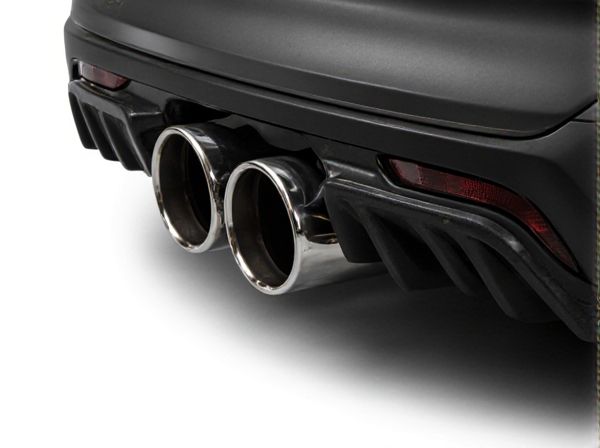
Photo illustration: Cat-back vs Turbo-back
Cat-back exhaust systems replace the piping from the catalytic converter to the tailpipe, improving airflow and enhancing your vehicle's performance and sound. Turbo-back systems upgrade the entire exhaust path from the turbocharger outlet to the tailpipe, offering greater power gains and reduced turbo lag by optimizing exhaust gas flow more comprehensively. Choosing between cat-back and turbo-back depends on your performance goals and budget, with turbo-back providing more significant gains but at a higher cost and complexity.
Table of Comparison
| Feature | Cat-back Exhaust | Turbo-back Exhaust |
|---|---|---|
| Definition | Exhaust system from catalytic converter to tailpipe | Complete exhaust, from turbocharger outlet to tailpipe |
| Performance Impact | Improves horsepower and sound moderately | Maximizes horsepower and turbo efficiency significantly |
| Cost | Generally lower priced | Higher cost due to full system replacement |
| Installation Complexity | Relatively easier, no turbo removal needed | More complex, requires turbo system disassembly |
| Sound Characteristics | Deeper tone, louder than stock | More aggressive, louder exhaust note |
| Emissions Compliance | Maintains catalytic converter, street legal | May remove cat, affecting emissions legality |
| Best For | Street performance and mild upgrades | Track-focused builds and maximum power |
Introduction to Exhaust Systems: Cat-back vs Turbo-back
Cat-back and turbo-back exhaust systems serve distinct functions in vehicle performance upgrades. Cat-back systems replace components from the catalytic converter to the exhaust tip, optimizing flow and sound while maintaining emissions compliance. Turbo-back systems extend from the turbocharger outlet through the entire exhaust path, significantly reducing backpressure and improving turbo efficiency for enhanced horsepower and torque.
What is a Cat-back Exhaust System?
A Cat-back exhaust system extends from the catalytic converter to the rear of the vehicle, including components like the muffler and tailpipe, designed to improve exhaust flow and enhance engine performance. It maintains emissions compliance by keeping the catalytic converter in place while reducing backpressure for better horsepower and torque. This setup offers a balanced upgrade with a deeper exhaust tone without the need for extensive modifications typical of a turbo-back system.
What is a Turbo-back Exhaust System?
A turbo-back exhaust system includes all components from the turbocharger outlet to the exhaust tip, replacing the factory piping with high-performance parts to reduce backpressure and improve exhaust flow. This system typically features larger diameter tubing, mandrel bends, and high-quality materials like stainless steel to enhance turbo efficiency and increase horsepower and torque. Compared to a cat-back system, turbo-back designs maximize performance gains by optimizing exhaust evacuation right from the turbo, benefiting turbocharged engines the most.
Key Differences Between Cat-back and Turbo-back
Cat-back exhaust systems replace the pipe from the catalytic converter to the exhaust tip, improving exhaust flow and sound without affecting emissions equipment. Turbo-back systems include all components from the turbocharger outlet to the exhaust tip, offering greater performance gains by reducing turbo lag and backpressure. Choosing between them depends on desired horsepower increase, noise level, and compatibility with emissions regulations.
Performance Gains: Cat-back vs Turbo-back
Turbo-back exhaust systems deliver superior performance gains compared to cat-back setups by replacing the entire exhaust system from the turbocharger to the tailpipe, which significantly reduces backpressure and enhances exhaust flow. Cat-back systems improve horsepower and torque by upgrading components downstream of the catalytic converter, but their impact is limited since the turbocharger's efficiency remains constrained by upstream restrictions. For maximum power output and turbo efficiency, turbo-back systems provide a more comprehensive solution by optimizing exhaust scavenging and turbo spool times.
Sound and Noise Levels Compared
Cat-back exhaust systems typically produce a deeper, more aggressive sound by enhancing the flow from the catalytic converter to the exhaust tip, resulting in moderate noise levels suitable for daily driving. Turbo-back systems replace the entire exhaust from the turbocharger to the tailpipe, often creating louder, more pronounced turbo spool noises and increased exhaust volume that enhances performance but may result in higher noise levels. Sound characteristics of cat-back systems favor a balanced tone, while turbo-back setups deliver a sharper, more race-inspired exhaust note with elevated noise intensity.
Emissions and Legal Considerations
Cat-back exhaust systems retain the catalytic converter, ensuring compliance with emissions regulations and reducing harmful pollutants. Turbo-back systems replace the entire exhaust from the turbocharger, often eliminating the catalytic converter, which may lead to increased emissions and legal issues. Vehicle owners must verify local laws to avoid fines and ensure their modifications meet environmental standards.
Installation Complexity and Costs
Cat-back exhaust systems typically offer easier installation due to fewer components and direct bolt-on fitment, making labor costs lower compared to turbo-back systems. Turbo-back systems require removal and replacement of the entire exhaust path from the turbocharger to the muffler, increasing both parts complexity and installation time, which drives up labor expenses. The increased complexity in turbo-back setups often necessitates professional tuning and potential modifications to accommodate the new piping, further elevating overall project costs.
Which Exhaust System is Right for You?
Choosing between a cat-back and turbo-back exhaust system depends on performance goals and vehicle setup; a cat-back system replaces the exhaust from the catalytic converter back, improving sound and horsepower without affecting emissions. A turbo-back exhaust includes the downpipe and benefits turbocharged engines by reducing backpressure and enhancing turbo spool time, leading to significant power gains. For naturally aspirated vehicles, a cat-back system often suffices, while turbo-back systems are ideal for maximizing turbocharged engine efficiency and overall performance.
Conclusion: Choosing Between Cat-back and Turbo-back
Choosing between cat-back and turbo-back exhaust systems depends on performance goals, budget, and vehicle compatibility. Cat-back systems offer a balance of improved sound and moderate power gains, ideal for daily drivers seeking enhanced exhaust flow without significant modifications. Turbo-back exhausts maximize horsepower and turbo efficiency but require a higher investment and may demand tuning adjustments to optimize performance.
 caratoz.com
caratoz.com